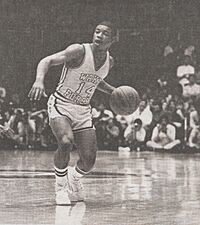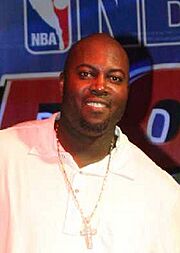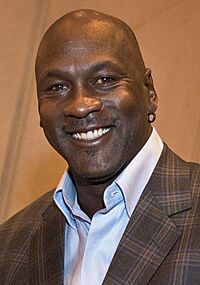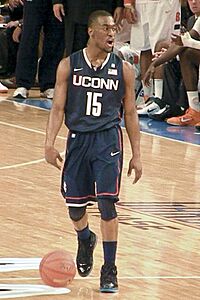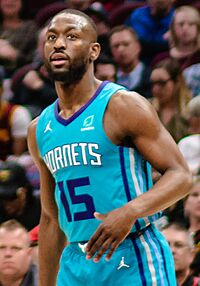History of the Charlotte Hornets facts for kids
The Charlotte Hornets are a professional basketball team based in Charlotte, North Carolina. Their story began in 1985 when George Shinn wanted to bring an NBA team to Charlotte. The Hornets started playing in 1988. After 14 seasons, the team moved to New Orleans in 2002.
Charlotte got a new team in 2004, called the Bobcats, owned by Robert L. Johnson. They played their first game in 2004. In 2010, basketball legend Michael Jordan bought the team. Jordan brought back the original "Hornets" name in 2014. In 2023, he sold the team to a group led by Rick Schnall and Gabe Plotkin. The team has reached the playoffs many times, but as of 2025, they are the oldest team in major North American sports that has never won a division championship.
Contents
Original Charlotte Hornets (1988–2002)
NBA Comes to Charlotte (1985–1988)
In 1985, the NBA planned to add four new teams. George Shinn, a businessman from North Carolina, wanted to bring a team to Charlotte. The city already loved college basketball, with many loyal fans for local teams. Charlotte was also growing fast.
Some people wondered if Charlotte could support an NBA team. But Shinn had a big advantage: the Charlotte Coliseum. This new arena could hold almost 24,000 fans, making it the largest basketball arena for an NBA team. On April 5, 1987, NBA Commissioner David Stern announced that Charlotte would get a team, starting in 1988. Other new teams were Miami, Minneapolis-Saint Paul, and Orlando.
The team was almost named the "Charlotte Spirit," but a contest chose "Hornets." This name came from the city's strong resistance during the American Revolution, when a British general called it "a veritable hornet's nest of rebellion." The name had been used by other Charlotte sports teams before.
The team chose a unique color: teal. This started a fashion trend in sports during the late 1980s and early 1990s. The uniforms were designed by Alexander Julian and were the first in the NBA to feature pinstripes.
Shinn hired Carl Scheer as the first general manager and Dick Harter as the first head coach. They wanted to build a competitive team quickly.
Early Seasons (1988–1992)
In their first season (1988–89), the Hornets were led by Kelly Tripucka, who was their top scorer. Other important players included rookie Rex Chapman and Muggsy Bogues, who was the shortest player in NBA history at 5'3". The Hornets' first game was a loss to the Cleveland Cavaliers on November 4, 1988. Four days later, they got their first win against the Los Angeles Clippers. On December 23, 1988, the Hornets famously beat Michael Jordan and the Chicago Bulls at the buzzer in Jordan's first professional game in North Carolina. The Hornets finished their first season with 20 wins and 62 losses.
Even though some thought the Coliseum was too big, the Hornets were very popular. They led the NBA in attendance in their first season and seven more times in Charlotte. They even sold out 364 games in a row!
The second season (1989–90) was tough. The team struggled, and coach Dick Harter was replaced by Gene Littles mid-season. They finished with 19 wins and 63 losses.
In the 1990 NBA draft, the Hornets picked guard Kendall Gill. The team improved in the 1990–91 season, finishing with 26 wins and 56 losses. Charlotte also hosted the 1991 NBA All-Star Game. After the season, Gene Littles was fired and replaced by general manager Allan Bristow.
Larry Johnson & Alonzo Mourning Era (1992–1995)
Drafting Larry Johnson (1991–92)
With the first pick in the 1991 NBA draft, the Hornets chose power forward Larry Johnson from UNLV. Johnson had a great first year, scoring and rebounding a lot, and winning the 1992 NBA Rookie of the Year Award. Kendall Gill also played well, averaging over 20 points per game. The team finished the season with 31 wins and 51 losses, showing improvement but still missing the playoffs.
First Playoff Appearance (1992–1994)
In the 1992 NBA draft, the Hornets got the second pick and chose center Alonzo Mourning from Georgetown. With Johnson, Mourning, and Kendall Gill, the Hornets had a very talented young group. In their fifth season (1992–93), the team had their first winning record at 44 wins and 38 losses. This was good enough for their first ever playoff spot. The Hornets surprised the Boston Celtics in the first round, with Mourning hitting a game-winning shot in Game 4. However, they lost to the New York Knicks in five games in the second round.
The Hornets finished the 1993–94 season with a 41–41 record, just missing the playoffs. The next season (1994–95), they won 50 games and returned to the playoffs. But Charlotte was knocked out in the first round by the Chicago Bulls.
Glen Rice Era (1995–1998)
The Johnson–Mourning era ended when the Hornets traded Mourning to the Miami Heat for forward Glen Rice, center Matt Geiger, and guard Khalid Reeves. Glen Rice quickly made a big impact, leading the team in scoring in the 1995–96 season. The team was competitive but missed the playoffs again, finishing 41–41. Allan Bristow resigned as coach and was replaced by NBA legend Dave Cowens.
Many changes happened in 1996. Kenny Anderson left, and Larry Johnson was traded to the Knicks for Anthony Mason. On draft day, the team traded Kobe Bryant (who they picked 13th) to the Los Angeles Lakers for center Vlade Divac. The new-look Hornets had a great season in 1996–97, winning 54 games and making it back to the playoffs. Glen Rice had an amazing season, finishing third in league scoring and winning the All-Star Game MVP award. Despite their regular season success, the Hornets lost to the Knicks in three straight games in the playoffs.
The 1997–98 season was also good. The team traded Muggsy Bogues and added point guard David Wesley and shooting guard Bobby Phills. With these players, the Hornets finished with a 51–31 record. Rice had another strong season. The Hornets made the playoffs for the second year in a row, reaching the second round, but were again stopped by the Bulls.
Final Years of Original Hornets (1998–2002)
The 1998–99 season was shorter due to a lockout. Glen Rice was traded to the Lakers for Eddie Jones and Elden Campbell. Coach Dave Cowens resigned mid-season and was replaced by Paul Silas. The team finished 26–24 but missed the playoffs.
The 1999–2000 season saw the team return to success with the addition of point guard Baron Davis. However, tragedy struck on January 12, 2000, when popular player Bobby Phills died in a car accident. The Hornets retired his No. 13 jersey. The team finished with 49 wins and 33 losses and returned to the playoffs, losing to the Philadelphia 76ers in the first round. Off the court, fan unhappiness with owner George Shinn's decisions caused attendance to drop.
In the 2000–01 season, with new players like Jamal Mashburn and P.J. Brown, the Hornets made the playoffs again, finishing 46–36. They upset the Heat in the first round but lost to the Milwaukee Bucks in seven games in the semifinals. Despite playing well, their popularity continued to fall, and attendance was very low.
The Hornets made the playoffs again in the 2001–02 season, finishing 44–38. They beat the Orlando Magic in the first round but lost to the New Jersey Nets in the Conference Semifinals. The team had the lowest attendance in the league. Before the playoffs ended, the NBA approved the team's move to New Orleans after the season.
Relocation to New Orleans (2002–2003)
Many people blamed the team's owner, George Shinn, for the drop in popularity. Shinn said the Hornets would leave Charlotte unless the city built a new arena for free. The city refused at first. Shinn considered moving the team to other cities.
Eventually, a plan for a new arena in Charlotte was proposed. However, a disagreement about city rules caused a public vote on the arena to fail. City leaders then found a way to build the arena without a public vote, but they said they wouldn't do it unless Shinn sold the team. The NBA allowed Shinn to move the team to New Orleans. As part of the deal, the NBA promised Charlotte a new expansion team in the future.
Charlotte Bobcats (2004–2014)
Establishing the Bobcats (2003)
The NBA wanted to add another team to balance its divisions. The league said it would consider putting that team in Charlotte for the 2004–05 season if an arena deal could be made. On December 18, 2002, a group led by Black Entertainment Television founder Robert L. Johnson was chosen. Johnson became the first African American majority owner in major U.S. professional sports.
In June 2003, the team was named the Bobcats. The name "Bobcats" was chosen because the bobcat is a fierce animal found in the Carolinas. There was a new arena built in Charlotte for the Bobcats, but the team played their first games at the old Coliseum until it was ready.
The Bobcats hired Bernie Bickerstaff as their first head coach and general manager.
Beginning of the Bobcats (2004–2008)
The Bobcats held their expansion draft on June 22, 2004, picking players like Gerald Wallace, Primož Brezec, and Jason Kapono. They also traded for the second pick in the 2004 NBA draft, which they used to select center Emeka Okafor. The Bobcats' first game was a loss to the Washington Wizards on November 4, 2004. Two days later, they won their first game against the Orlando Magic. On December 14, the Bobcats beat the New Orleans Hornets in overtime, which was the Hornets' first game back in Charlotte after their move. The Bobcats struggled in their first season, finishing with 18 wins and 64 losses. Emeka Okafor played well and won the 2004–05 NBA Rookie of the Year Award.
In the 2005 NBA draft, the Bobcats drafted Raymond Felton and Sean May. In their second season (2005–06), the Bobcats opened their new arena with a win over the Boston Celtics. They finished with 26 wins and 56 losses, an improvement from their first year. After the season, Michael Jordan bought a part of the team and became head of basketball operations.
The Bobcats showed some improvement in the 2006–07 season. However, they had a long losing streak. Michael Jordan announced that coach Bernie Bickerstaff would not return the next season. The Bobcats finished with 33 wins and 49 losses.
In 2007, Rod Higgins was hired as general manager, and Sam Vincent became the second head coach. In the 2007 NBA draft, the Bobcats traded for Jason Richardson. The team finished the 2007–08 season with a disappointing 32 wins and 50 losses. Coach Vincent was fired on April 26, 2008.
Larry Brown Era (2008–2010)
On April 29, 2008, the Bobcats hired Basketball Hall of Famer Larry Brown as their third head coach. In the 2008 NBA draft, they selected D. J. Augustin. In December 2008, the Bobcats traded leading scorer Jason Richardson for Boris Diaw and Raja Bell. This trade helped the team, and they came close to making the playoffs in the 2008–09 season, finishing with a team record of 35 wins and 47 losses. After the season, Robert L. Johnson announced he was selling the team.
Playoffs, New Ownership & Struggles (2009–2012)
In the 2009 NBA draft, the Bobcats picked Gerald Henderson. They also traded Emeka Okafor for center Tyson Chandler and acquired Stephen Jackson. On February 27, 2010, Robert Johnson sold the team to Michael Jordan, making him the first former NBA player to own a majority share of a team.
On April 9, 2010, the Bobcats made their first playoff appearance with a win over the New Orleans Hornets. They finished the 2009–10 season with a winning record of 44 wins and 38 losses. Gerald Wallace became the first Bobcats player to be selected as an NBA All-Star. However, the Bobcats were swept by the Orlando Magic in the first round of the playoffs.
Kemba Walker Era Begins (2011–2019)
The Bobcats started the 2010–11 season with high hopes but struggled. On December 22, 2010, Larry Brown stepped down as head coach, and Paul Silas returned to Charlotte. The team traded Gerald Wallace and Nazr Mohammed to clear salary space. The Bobcats finished the season with 34 wins and 48 losses.
On June 13, 2011, Rich Cho was hired as general manager. In the 2011 NBA draft, the Bobcats traded for the 7th overall pick and used it to draft Bismack Biyombo. They also drafted Kemba Walker, the NCAA tournament's Most Outstanding Player, with the 9th pick. The Bobcats struggled in the lockout-shortened 2011–12 season, posting an NBA-worst record of 7 wins and 59 losses. This set a record for the worst winning percentage by an NBA team. On April 30, 2012, Silas was let go. Mike Dunlap was named his replacement.
Despite having the best chance for the first pick, the Bobcats got the second pick in the 2012 NBA draft and selected Michael Kidd-Gilchrist. They also added players like Ben Gordon and Ramon Sessions. The Bobcats started the 2012–13 season with a win, snapping their 23-game losing streak. However, they then went on an 18-game losing streak. They finished with 21 wins and 61 losses. On April 23, 2013, Dunlap was fired. He was replaced by former Lakers assistant coach Steve Clifford.
Final Years as the Bobcats (2012–2014)
On May 21, 2013, Michael Jordan announced that the team had applied to change its name back to the Charlotte Hornets for the 2014–15 season. The New Orleans Hornets had recently changed their name to the New Orleans Pelicans. On July 18, 2013, the NBA approved the Charlotte Bobcats to reclaim the Hornets name.
In the 2013 NBA draft, the Bobcats selected Cody Zeller. They also signed Al Jefferson during free agency.
On November 22, the Bobcats announced they would use a modified version of the original Hornets' teal-purple-white colors. The team showed off its new logo in December, with former Hornets players like Dell Curry and Muggsy Bogues present. They started a campaign called "Buzz City" to celebrate the Hornets' return.
On February 20, 2014, the Bobcats traded for Gary Neal and Luke Ridnour. The Bobcats made the playoffs for the second time in franchise history on April 5, 2014. They finished the 2013–14 regular season with 43 wins and 39 losses, their second-highest win total. The Bobcats were swept by the defending champion Miami Heat in the first round of the 2014 NBA Playoffs. This was their last game as the Charlotte Bobcats.
Return of the Hornets (2014–present)
Return of the Hornets & Buzz City (2014–15)
On May 20, 2014, the Bobcats officially became the Charlotte Hornets again. The team also announced that they would reclaim the history and records of the original 1988–2002 Hornets. This means the Hornets are now seen as having paused operations from 2002 to 2004, while the Pelicans are considered a new team that started in 2002.
In the 2014 NBA draft, the Hornets selected Noah Vonleh. They also made several trades. During free agency, the Hornets signed Lance Stephenson and Marvin Williams. They also added Brian Roberts, who became the first player to play for both the New Orleans Hornets and the Charlotte Hornets. Charlotte finished the 2014–15 season with 33 wins and 49 losses.
Return to Playoffs & Struggles (2015–2017)
After their first season as the "reborn" Hornets, the team signed and traded for promising players like Nicolas Batum, Jeremy Lin, and Jeremy Lamb. In the 2015 NBA draft, the Hornets selected Frank Kaminsky.
The Hornets started the 2015–16 season well. They had a great run after February 1, winning 25 of 34 games. On April 2, the Hornets secured a playoff spot. They finished with 48 wins and 34 losses, their most regular season victories since the 1999–00 season. Charlotte earned the No. 6 seed in the Eastern Conference playoffs and played the No. 3 seed Miami Heat. The Heat won the first two games, but the Hornets won Game 3, their first playoff victory since 2002. Charlotte won the next two games but lost Game 6 at home and Game 7 in Miami, ending their season.
In the 2016–17 offseason, Jeremy Lin, Al Jefferson, and Courtney Lee left the team. The Hornets re-signed Nicolas Batum and Marvin Williams and brought in Roy Hibbert and Marco Belinelli. Hibbert was later traded. Kemba Walker was named an Eastern Conference All-Star, his first All-Star selection. The Hornets finished the season with 36 wins and 46 losses, missing the playoffs.
Final Years of Kemba Walker Era (2017–2019)
The Hornets had a good offseason in 2017, trading for Dwight Howard. In the 2017 NBA draft, the Hornets drafted Malik Monk. They also signed Michael Carter-Williams.
The Hornets started the season with a loss but then won three games in a row. However, they then lost six straight. On February 4, Kemba Walker broke the franchise record for 3-pointers made. On February 7, the Hornets traded for Willy Hernangómez. On February 8, Walker made his second straight All-Star appearance. On March 28, Walker passed Dell Curry to become the franchise's all-time leading scorer. The Hornets finished the season with 36 wins and 46 losses, missing the playoffs again. On April 18, coach Steve Clifford was let go. On May 9, James Borrego was hired as the new head coach.
The 2018–19 season marked the Hornets' 30th year in the NBA. Charlotte was chosen to host the 2019 NBA All-Star Game.
Before the 2018 NBA draft, the Hornets traded Dwight Howard. Through the draft, the team acquired Miles Bridges and Devonte Graham. On July 23, the Hornets signed Tony Parker.
The Hornets were 27–30 at the All-Star break. Kemba Walker was announced as a starter for the 2019 NBA All-Star Game. On the final game of the season, the Hornets needed a win and for another team to lose to make the playoffs. Unfortunately, the Hornets lost, missing the playoffs for the third year in a row. This was also the first time Tony Parker missed the playoffs in his career. On June 11, Parker announced his retirement.
Post-Walker Era (2019–present)
Walker's Departure & Season Suspension (2019–20)
The Hornets acquired P. J. Washington, Cody Martin, and Jalen McDaniels from the 2019 NBA draft. On July 6, Kemba Walker was traded to the Boston Celtics for Terry Rozier, marking the end of Walker's time with the team.
The new season started with a win over the Chicago Bulls. The team had a long losing streak in January. On March 11, the NBA announced the season's suspension due to the COVID-19 pandemic. The Hornets were 23 wins and 42 losses when the season was stopped. The Hornets were one of eight teams not invited to play in the 2020 NBA Bubble.
LaMelo Ball Era (2020–present)
With the 3rd pick of the 2020 NBA draft, the Hornets selected guard LaMelo Ball. Ball had played high school basketball and professionally in Lithuania and Australia before the NBA draft. In the same draft, the Hornets also selected Vernon Carey Jr. and Grant Riller, and acquired Nick Richards. On November 29, the Hornets waived Nicolas Batum and officially acquired forward Gordon Hayward from the Boston Celtics. The next day, the team officially signed Ball.
The Hornets lost their first game with Ball, who went scoreless in his debut. Three days later, they lost a close game at home to the Thunder.
In the 2022–23 season, the Hornets faced many injuries. They had a disappointing season with 27 wins and 55 losses, one of the lowest records in the league. Despite this, Mark Williams showed great promise.
Their low record led them to secure the second overall pick in the 2023 NBA draft, which they used to draft Brandon Miller.
On June 16, 2023, Michael Jordan announced he would sell his majority share in the team to a group led by Gabe Plotkin and Rick Schnall. The deal was approved by the NBA on July 23, 2023.
|


